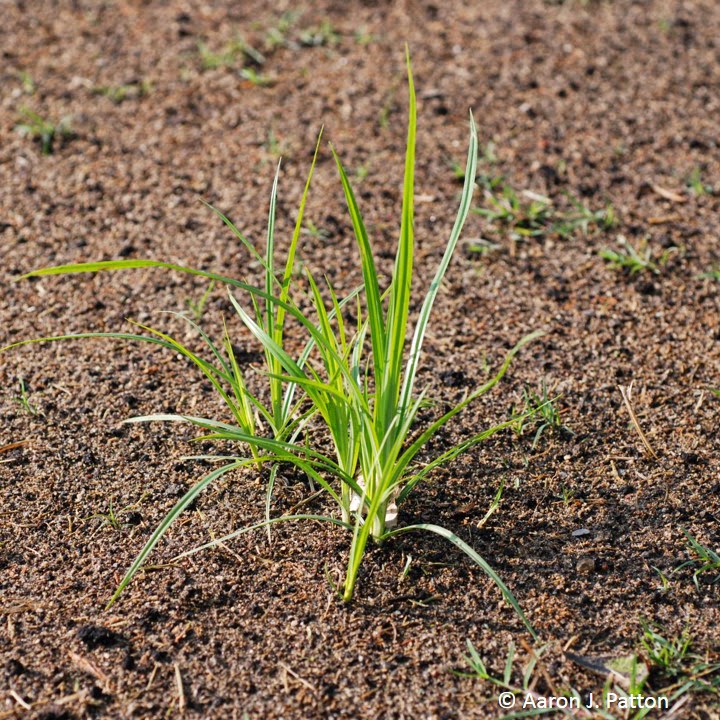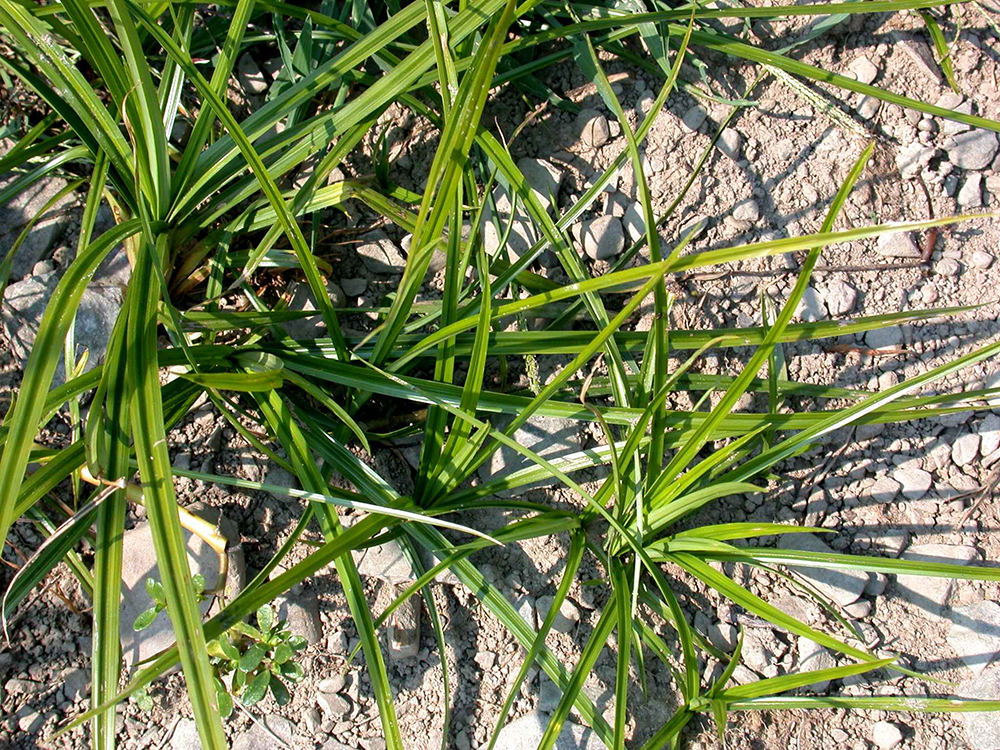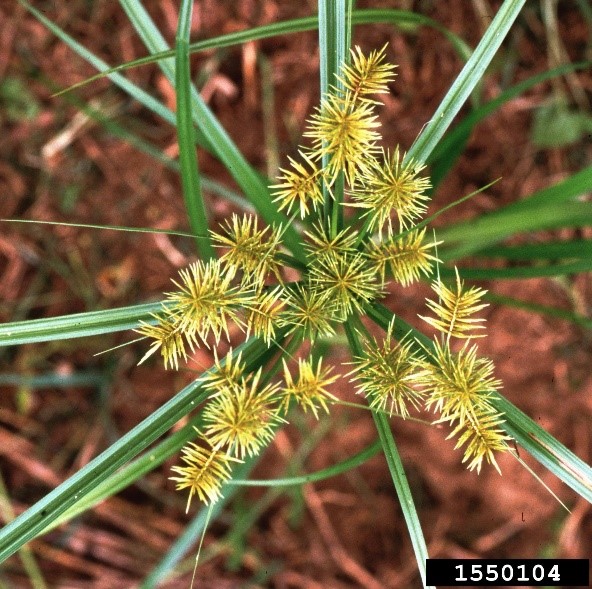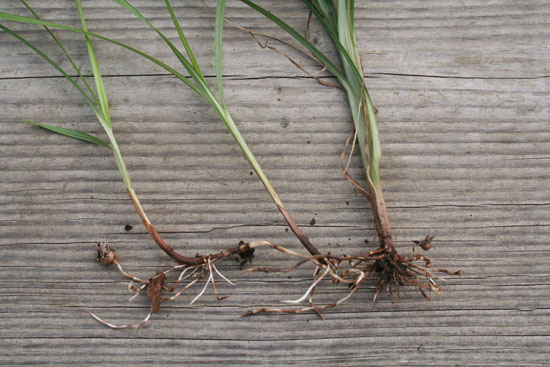Main Content

Written by Joanna Guldin, Rowan College of South Jersey, Gloucester County Intern Scholarship Program
Yellow nutsedge (Cyperus esculentus L.) is a perennial weed in the sedge family native to North America and found throughout the United States. This weed can be easily identified by its bright green foliage and golden-yellow flower heads.
Importance as an Agricultural Weed
Yellow Nutsedge is an aggressive and persistent weed, which makes it challenging to eradicate and difficult to control. In agricultural fields, these weeds are troublesome because they compete against many crops for moisture, nutrients, and light. Avoid planting potatoes in fields infested with Yellow Nutsedge because the weeds pointed rhizomes can penetrate potato tubers and destroy the crop. The pointed tip of newly emerged leaves can also pierce through horticultural plastic films widely used for vegetable production.
Generally, soybeans and corn will outgrow and shade Yellow Nutsedge, but a severe infestation can reduce soybean and corn yields.
During the frost-free seasons, Yellow Nutsedge spreads and propagates through an extensive underground network of rhizomes and tubers. These tubers are very difficult to remove because they spread rapidly, with one plant producing several hundred to several thousand tubers within one growing season. Under ideal conditions, tubers can persist in the soil for three years.
Key Characteristics for Identification
| Characteristics | Description |
| Overall Appearance | Bright green foliage Grass stems are hollow and round Longer stems that grow up to 3 ft tall Simple leaf blade with no sheath or collar |
| Leaf Attributes | Thicker and stiffer than most grasses V-shaped in cross-section Arranged in sets of three from the base Light green leaves with a pointed tip Width of 1/6 to 2/5 of an inch |
| Presence of Hairs | Stem is hairless |
| Flowers | Golden-yellow spikelets Flowering stems are triangular in cross-section |
Chemical Control Options
For herbicide recommendations, refer to the following publications. Additional commercial crop production guides can be found here. Contact your local county Extension office with specific questions.
- Field Crops: Mid-Atlantic Field Crop Weed Management Guide
- Vegetable Crops: Mid-Atlantic Commercial Vegetable Production Recommendations
- Turfgrass: NJAES Factsheet 385 Broadleaf Weed Control in Cool Season Turfgrasses
- Home Landscape: NJAES Bulletin 272 Weed Management in Ornamental Plantings
Important Note: ALS-inhibitors (group 2) are commonly used to control weeds like yellow nutsedge across a range of cropping systems. Diligence is needed to prevent development of herbicide resistant yellow nutsedge biotypes on your farm as biotypes resistant to ALS-inhibitor herbicides have been confirmed in Arkansas. When utilizing ALS-inhibitor herbicides, use the full label rate and tank-mix with another effective herbicide mode of action.
Integrated Weed Management Strategies
Yellow nutsedge can be easily killed with tillage after the tubers have sprouted in late spring and early summer. Tillage would bring rhizomes and tubers to the surface, which would cause them to dry out or freeze. Tubers can make new sprouts from dormant buds; however, tillage will make these sprouts weaker and easier to control. Tillage is also effective in disrupting tuber formation after harvest in late summer and fall.
Crop rotations are effective in suppressing yellow nutsedge. Highly competitive crops such as corn and soybean can shade yellow nutsedge, thereby reducing growth and tuber formation. Allelopathic crops like sweet potato and rye have also been shown to reduce nutsedge vigor and growth.
Occasional grazing by swine can effectively control yellow nutsedge infestation. Hogs scavenge and eat the buried nutlets of the plant and have the capacity to reduce nutsedge in a short period of time.



References
Anonymous. Yellow Nutsedge (Cyperus esculentus). University of California & Natural Resources.
Heap, I. The International Herbicide-Resistant Weed Database. Online. Wednesday, March 30, 2022. Available www.weedscience.org
Lingenfelter, D., Curran, W.S. (2017, September 18). Controlling Yellow Nutsedge in Agronomic Crops (An Integrated Approach). PennState University. https://extension.psu.edu/controlling-yellow-nutsedge-in-agronomic-crops-an-integrated-approach
Mohler, C.L., Teasdale, J.R., & DiTommaso, A. (2021). Major agricultural weeds of the United States and Canada. In L. Barba (Ed.), Manage weeds on your farm: A guide to ecological strategies (pp. 211-214). Sustainable Agriculture Research and Education.
Schonbeck, M. (2019, October 14). Yellow Nutsedge (Cyperus esculentus) in Greater Depth. eOrganic.